 Unfortunately these won't look like much unless you enlarge them and even then they're not reproduced big enough for the full impact to get across. I can't figure out why some graphics make such a bold statement when blown up and others don't.
Unfortunately these won't look like much unless you enlarge them and even then they're not reproduced big enough for the full impact to get across. I can't figure out why some graphics make such a bold statement when blown up and others don't.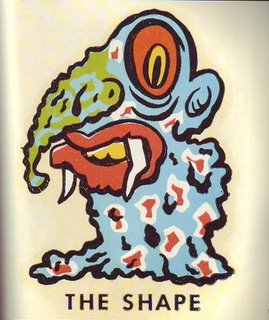

 I've always wanted a set of muscles like the ones on the Doc Savage covers. That and a whole closet of torn t-shirts. The problem is that working out is boring, or at least it seems that way to someone who doesn't do it. There must be another way...
I've always wanted a set of muscles like the ones on the Doc Savage covers. That and a whole closet of torn t-shirts. The problem is that working out is boring, or at least it seems that way to someone who doesn't do it. There must be another way... And this is it! It's a little elaborate, maybe a tad expensive, but this guy is on the right track I think. A suggestion: loose the padded pants. They detract from the realism. That top combined with natural, skinny legs would be a killer combination!
And this is it! It's a little elaborate, maybe a tad expensive, but this guy is on the right track I think. A suggestion: loose the padded pants. They detract from the realism. That top combined with natural, skinny legs would be a killer combination! Every year I hope the Halloween costume industry will put out a good set of fake muscles but they never do. Look at the tacky shirt this kid (above) is wearing. The muscles look like curdled milk. Oh well, maybe next year.
Every year I hope the Halloween costume industry will put out a good set of fake muscles but they never do. Look at the tacky shirt this kid (above) is wearing. The muscles look like curdled milk. Oh well, maybe next year.
 I love these two masks of womens' faces. They're both funny, vivd and full of energy. I especially like the bukram mask of the girl with black eyebrows. Bukram is a great medium. It allows for mass production but it retains the feel of a customized piece of folk art. There's a web site that has detailed instructions on how to make bukram masks. I may take a stab at it sometime. The monochrome mask with the big teeth is kind of ugly but I offer it here because a frontal view on an upshot face is an interesting juxtaposition. The cardboard witch and the Opper-style cartoon characters are
I love these two masks of womens' faces. They're both funny, vivd and full of energy. I especially like the bukram mask of the girl with black eyebrows. Bukram is a great medium. It allows for mass production but it retains the feel of a customized piece of folk art. There's a web site that has detailed instructions on how to make bukram masks. I may take a stab at it sometime. The monochrome mask with the big teeth is kind of ugly but I offer it here because a frontal view on an upshot face is an interesting juxtaposition. The cardboard witch and the Opper-style cartoon characters are  nifty examples
nifty examples 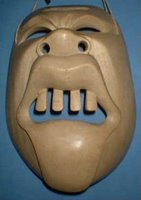 of good design that's made to sell for pennies. The witch looks like it was influenced by Nabi theories.
of good design that's made to sell for pennies. The witch looks like it was influenced by Nabi theories.

 Bosom is a Victorian word that you don't hear too often nowadays. It denotes breasts which are not just big but are...expansive. Do Dolly Parton and Jane Mansfield have bosoms? Yes, I think so but I can't say for sure without examining them. A real bosom requires a certain amount of chest area above the boobs. I'm not a bosom fetishist, mind you, I like all kinds of breasts, but
Bosom is a Victorian word that you don't hear too often nowadays. It denotes breasts which are not just big but are...expansive. Do Dolly Parton and Jane Mansfield have bosoms? Yes, I think so but I can't say for sure without examining them. A real bosom requires a certain amount of chest area above the boobs. I'm not a bosom fetishist, mind you, I like all kinds of breasts, but 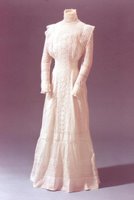 like all men I follow any news about this area with keen interest.
like all men I follow any news about this area with keen interest.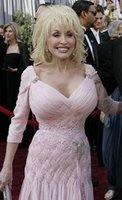


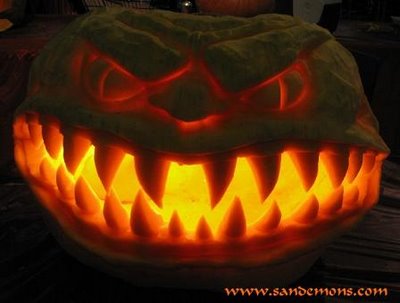 Here's (above) a technique I haven't seen before. The pumpkin is stripped of all it's skin and the pulp is sculpted by itself. When it's lit with a candle the face is eerie and luminous.
Here's (above) a technique I haven't seen before. The pumpkin is stripped of all it's skin and the pulp is sculpted by itself. When it's lit with a candle the face is eerie and luminous.


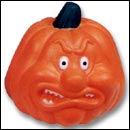



 I like secular people...most of my friends are secular...but this post is a criticism of an extreme of secularism, something that historian Niall Ferguson calls vacuous secularism. The vacuous variety believes that religion (Christianity in the case of the West) never accomplished anything of value and was never anything but an obstacle to progress. That's just silly.
I like secular people...most of my friends are secular...but this post is a criticism of an extreme of secularism, something that historian Niall Ferguson calls vacuous secularism. The vacuous variety believes that religion (Christianity in the case of the West) never accomplished anything of value and was never anything but an obstacle to progress. That's just silly.